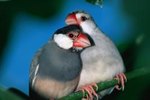
The expression “form follows function” is exemplified by the varied shapes of bird’s beaks, which illustrate that there is indeed a right tool for every job. From the long spear-like beak of a stork to the short, conical beak of a cardinal, nature designed each beak to do a precise job. Understanding the job implied by each beak shape helps us to understand something about the environment in which a bird lives.
Nature’s Tool Brigade
Many bird beaks resembles the tools one might find in a carpenter’s toolbox. The woodpecker uses his strong bill -- attached to an equally sturdy skull -- like a hammer and chisel to chip holes into trees. Cardinals, sparrows and other seed-eating birds crush hard shells in their viselike beaks; and the crow has been likened to a Swiss army knife for its wonderful multi-purpose beak, capable of alternately chiseling, hammering, crushing and cutting. Each species uses its beak to find the food available in its particular habitat -- trees, grasses and other seed-producing plants, fruits, or insects and animals -- and knowing what a bird eats offers clues about its preferred habitat.
Not Every Bill Is a Sucker
Sometimes the purpose of a beak design is not immediately apparent -- take the many pointy-billed birds, for example. They all have long, slender beaks. However, the hummingbird enjoys drinking nectar from tubular flowers, so needs a long straw-like beak for that job -- and a lot of flowery habitat to ensure a good meal. The similar shape of a kingfisher’s or heron’s bill is designed for spearing fish, so a river, lake or other body of water is perfect for him. The tiny warblers with pointy beaks have a different agenda altogether as well as a different preference in homes. Woodland habitat is ideal for their tweezer-like beaks, designed for plucking insects from beneath bark and out of small holes.
Water Sports
Herons and storks aren’t the only birds adapted to using bodies of water. Flat-billed ducks strain small organisms through their bills, while flamingoes turn their heads completely upside down to scoop food from the shallow marshes they favor. Meat-eaters like pelicans can both snatch up fish with their pointy beaks and store it in the pouch underneath. Many birds of prey -- such as the bald eagle -- although designed by nature for tearing and shredding much tougher meat, like to eat fish as well. An abundance of beak shapes indicate that many food resources may be found near water and many varied birds prefer this habitat at mealtime.
What Beaks Can’t Say
While beak shape can offer clues about where a bird prefers to eat, and by extension where it likely prefers to live, this is not always enough. The shape of a beak is a good place to start because most animals like to live where their favorite foods are abundant, but determining a species’ home niche often requires looking at other physical characteristics. A duck’s webbed feet furnishes a good example of a secondary characteristic verifying that watery habitat is ideal for that bird. In fact, foot shape offers the major additional clue to determining a bird’s favorite place to live in nearly all bird species.
References
Resources
Photo Credits
-
Photodisc/Photodisc/Getty Images



